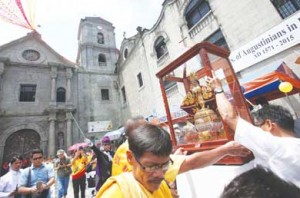Devotees of the Santo Niño de Cebu were given the chance to have a glimpse of the pilgrim image in Manila at the San Agustin Church in Intramuros Manila.
Fr. Harold Rentoria, an Augustinian priest and commissioner of the National Commission for Culture and the Arts (NCCA), pointed out the unique devotion of Cebuanos to the Holy Child.
“It is in the way they wave their hands and sing (devotional) songs. Even the singing (of the Gozos), it (devotion) comes from the heart,” Rentoria told The Manila Times.
Gozos refers a collection of religious verses formed into a hymn. Santo Niño de Cebu devotees particularly sing the hymn ‘Batobalani sa Gugma? (Magnet of Love), during novena masses. The hymn, according to heritage writer Trizer Dale Mansueto, was first published in novena booklets in 1888.
Rentoria added that the devotion to the Sto. Niño is already ingrained in the culture and history of Cebu.
Rentoria underscored that such is expected as the devotion to the Santo Niño started in Cebu, which is also called the ‘Cradle of Christianity.’
The icon, which is more than 400 years old was given as a gift by Portuguese explorer Ferdinand Magellan to Queen Juana, the wife of Cebu chieftain Rajah Humabon.
Augustinian friars at the Basilica Minore del Santo Niño have kept the image, which has become fragile with time, beside the main altar of the church and encased in bullet-proof glass.
Once a year, during its feast in January, a replica of the centuries-old image of the Holy Child is adorned with gold and jewelry as a child-king.
The celebration of the feast of the Santo Niño or the Sinulog starts with the Misa de Traslacion, before the image is taken from the Basilica in Cebu City to the National Shrine of Saint Joseph in Mandaue City through a motorcade. An overnight prayer vigil is then held at the church.
The next day, the image is taken to a yacht made to look like a Spanish galleon and carried through Mactan channel accompanied by hundreds of vessels of various shapes and sizes.
In the afternoon, on the same day, the image enclosed inside a glass case goes on procession through the streets of Cebu City. The activity is attended by at least a million devotees holding on to rosaries and candles uttering prayers for miracles and thanksgiving for graces received.
On Sunday, Aug. 16,the fluvial procession of the Sto. Niño de Cebu will be reenacted in Manila as the pilgrim image specifically assigned to tour different provinces in Luzon, will be brought from Intramuros in Manila to Barangay Guadalupe in Makati City passing through the Pasig River.
At least six ferry boats of the MMDA will join the fluvial parade which starts at 8 a.m. Over a hundred other vessels are also expected to participate.
Rentoria said he witnessed the devotion of the Cebuanos to the Holy Child but other regions have their unique way of expressing the same devotion.
This practice, he added, reflects the unique cultural aspect of the different regions in the country.
He said there are three pilgrim images travelling to Luzon, Visayas and Mindanao during the year-long celebration of the presence of the Augustinian community in the Philippines that has lasted for about 450 years.
The image has been brought to Bulacan, Antipolo, Bicol in Luzon and Butuan, Cagayan de Oro in Mindanao and Panay Island in the Visayas.
The story of the Santo Niño and his faithful devotees continue as Augustinian friars visit cities and towns around the country and hold masses, conduct evangelization seminars and processions.
“(The devotion) reflects our faith in the Santo Niño, who is a symbol of our Catholic faith,” Rentoria said.
He added that through the religious activities organized by the religious congregation would help deepen the people’s faith.
“Not simply because of the image of the Holy Child but the faith planted in us by God,” he said.


